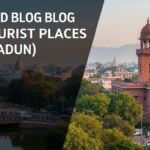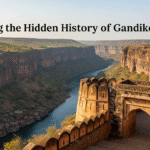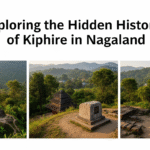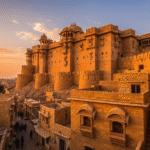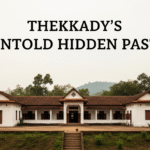Have you felt history’s whisper while standing on old grounds? Gwalior takes you on a mesmerizing time journey. This city is rich in Indian culture. In Gwalior, every corner has a story and every monument makes the past come alive. Fans of grand forts, beautiful temples, or big museums will love it here.
Gwalior is called Madhya Pradesh’s tourism gem. It has many must-see spots. The grand Gwalior Fort stands tall over the city. The legendary musician Tansen is honored here too. His music festivals draw many visitors. Places like Padmavati Pawaya and the beautiful Tighra Dam create lasting memories.
There are lively markets such as Sarafa Bazar, full of local crafts. The peaceful Sun Temple is here too. Gwalior’s history shows in its grand buildings. This makes it one of the best places to visit in Gwalior. The Gwalior Zoo adds nature to the city.
Every visit to Gwalior is like starting a new story. You might explore forts, shop in colorful bazaars, or enjoy the culture. This city keeps its history alive and invites you to join in.
Key Takeaways
- Gwalior Fort covers an area of 3 sq. km and requires almost a day to explore.
- Jai Vilas Palace charges an entry fee of ₹140 for Indians and ₹800 for Foreign Tourists.
- Sarafa Bazar operates from 10:00 am to 10:00 pm, bustling with local crafts and textiles.
- Tansen Memorial holds an annual music festival in November and December.
- The Gwalior Zoo, founded in 1922, charges ₹20 per adult and is closed on Fridays.
Gwalior Fort: The Crown Jewel of Gwalior
Gwalior Fort stands tall over the city. It is a key historical place in Gwalior. Called ‘the pearl among fortresses in India,’ it shows a story of strength. The fort covers 3 sq. km. It shows Gwalior’s important role in India’s past.
History and Significance
The fort was built in the eighth century. It has seen many dynasties rule, making it important. Gwalior Fort is a top site in Madhya Pradesh on UNESCO’s tentative list. The Man Mandir Palace, made by Raja Maan Singh Tomar, shows Gwalior’s royal past. The fort has many events and rulers in its history.
Points of Interest
Visitors will love the fort’s palaces, temples, and water tanks. The Man Mandir Palace is amazing. The Sas-Bahu Temple, made by King Mahipala, is for Lord Vishnu and Lakshmi. The Teli Ka Mandir shows ancient India’s architecture. The fort blends history and art.
Visitor Information
The fort is open every day. Tickets are affordable for all visitors. You might need a full day to see everything. A visit here lets you explore historical places and see India’s culture and architecture.
| Attraction | Highlights | Era |
|---|---|---|
| Gwalior Fort | Majestic fort with palaces and temples | 8th Century AD |
| Man Mandir Palace | Palace built by Raja Maan Singh Tomar | 1486-1516 AD |
| Sas-Bahu Temple | Temple honoring Lord Vishnu and Lakshmi | 11th Century AD |
| Teli Ka Mandir | Architectural diversity | 11th Century AD |
Discover the Royal Legacy at Jai Vilas Palace
Visit Jai Vilas Palace to see Gwalior’s royal history. It was built in 1874 for King Edward VII’s visit. The Scindia family still lives there, showing Gwalior’s rich past.
Architectural Marvels
The palace shows European design. Its Durbar Hall has big chandeliers and a huge carpet. It took twelve years to make. It shows how the royal family lived in style.
Exhibits and Museums
The Scindia Museum inside has many old items. You can see art, coins, and old weapons. There are also royal clothes, old cars, and furniture. It’s great for those who love art and history.
Visitor Tips
You can visit from 10:00 AM to 4:30 PM. It’s open every day but Mondays and holidays. They charge different fees for Indian and foreign tourists. You should plan enough time to see everything.
Photos are usually OK for personal use. But, there might be some rules. The palace offers tours too. They give you a lot of interesting facts. Dress nicely to respect this important place.
- Address: Near Gwalior Fort, about 3 km away
- Nearest Railway Station: Gwalior Junction Railway Station, 3 km away
- Transportation: You can get there by car, taxi, or auto-rickshaw
Jai Vilas Palace is a key spot in Gwalior. It shows the area’s royal history and beautiful design.
Exploring the Ancient Temples and Religious Sites
Gwalior is known as the ‘City of Temples’. It has historical temples with detailed carvings. Each temple shows the area’s rich history and culture. People visiting Gwalior can see the ancient beauty. Many temples are in the famous Gwalior Fort complex.
Teli Ka Mandir
The Teli Ka Mandir temple is famous in Gwalior. It has Hindu and Buddhist designs and is very old. It honors Lord Vishnu and stands in Gwalior Fort. This place shows Gwalior’s old building style.

Sun Temple
The Sun Temple Gwalior looks like the Sun Temple of Konark. It’s made of red sandstone and white marble. The temple is known for its beauty and skill. It is a key Gwalior religious site. Many people come to see its beauty.
Sas-Bahu Temple
The Sas-Bahu Temple is in the Gwalior Fort. It’s for Lord Vishnu and shows great art. These temples are very old. They show how people back then loved God and built amazing things. The Sas-Bahu Temple is a must-see in Gwalior for everyone.
Tourist Places in Gwalior Not to be Missed
Gwalior is full of history and culture. It has many interesting places to visit. Here are some important places you should see.
Gujari Mahal
The Gujari Mahal was built in the 15th century. Raja Man Singh made it for his queen, Mrignayani. It’s a great example of old architecture. Today, it’s a museum with many old things. It shows Hindu and Jain culture and has a famous statue. It’s a must-see in Gwalior.
Gopachal Parvat
Gopachal Parvat is inside Gwalior Fort. It has huge Jain sculptures from long ago. The carvings are detailed. This place is important for history and spirituality. It’s a special place that everyone should visit.
Tomb of Ghaus Mohammed
The Tomb of Ghaus Mohammed is from the Mughal time. It’s also known as Tansen ka Maqbara. Ghaus Mohammed was a famous Sufi saint and musician. This place has beautiful stone work. It shows Mughal art. It’s important for learning about history and spirituality.
| Place | Visiting Hours | Entry Fee |
|---|---|---|
| Gujari Mahal | 10:00 AM – 5:00 PM | ₹ 10 for Indians, ₹ 100 for Foreign Tourists |
| Gopachal Parvat | Sunrise to Sunset | Free |
| Tomb of Ghaus Mohammed | 10:00 AM – 6:00 PM | Free |
Conclusion
Gwalior is a mix of history, culture, and architecture. It is known as the “City of Music” by UNESCO. It draws visitors with its deep history and beautiful monuments. On top of a great hill, the Gwalior Fort stands out. It’s an 8th-century fort with the Man Mandir Palace from the 15th century inside.
The city’s spiritual spots are stunning. The Teli Ka Mandir shows amazing Dravidian art. The Sahastrabahu Temple is also fascinating. The Sun Temple, made in 1988, and the sacred Gurudwara Data Bandi Chhor Sahib are must-sees. They tell the story of the sixth Sikh Guru’s time in prison. The Jai Vilas Palace and Usha Kiran Palace show rich royal history.
Searches like must-see places in Gwalior show it’s a gem for history buffs and art lovers. You can see green spaces like Gwalior Zoo. Or explore ancient spots like the Chausath Yogini Temple. Each place offers a unique experience. Gwalior’s mix of attractions makes it essential for experiencing India’s heritage and culture.
FAQ
What are the best places to visit in Gwalior?
In Gwalior, don’t miss the Gwalior Fort and Jai Vilas Palace. You should also see ancient temples like Teli Ka Mandir and Sas-Bahu Temple, and visit the Gwalior Zoo.
What is the significance of the Gwalior Fort?
Known as ‘the pearl among fortresses in India,’ Gwalior Fort has a deep history. It faced many sieges. It tells stories of power and resistance, showing stunning historical architecture.
What can one find in the Jai Vilas Palace Museum?
The Jai Vilas Palace Museum shows how royalty lived. It displays art, furniture, and textiles from past times. The Durbar Hall, with big chandeliers and a huge carpet, is a must-see.
Are there any must-see ancient temples in Gwalior?
Yes, don’t miss the Teli Ka Mandir and Sas-Bahu Temple. The Teli Ka Mandir mixes Hindu and Buddhist designs. Sas-Bahu Temple is famous for its detailed carvings.
What is the Gujari Mahal and what does it offer?
The Gujari Mahal, from the 15th century, is now a museum. Raja Man Singh built it. It shows historical items, teaching about Jain and Hindu culture.
Where can one find significant Jain monuments in Gwalior?
Find key Jain monuments at Gopachal Parvat inside the Gwalior Fort area. It has big Jain sculptures cut from rock, made from the 7th to the 15th centuries.
What is unique about the Tomb of Ghaus Mohammed?
The Tomb of Ghaus Mohammed stands out for its Mughal architecture. It has hexagonal pavilions and fine stone work. It’s a key historical and spiritual spot.
How can one explore Gwalior’s local culture and handicrafts?
To see Gwalior’s culture and crafts, visit the lively Sarafa Bazar. It’s well-known for handicrafts, textiles, and local food.

